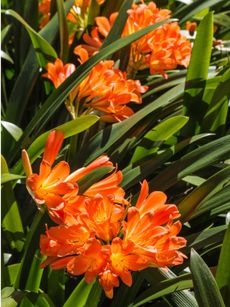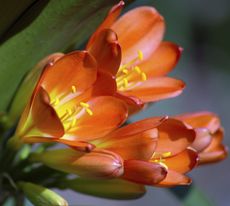Growing Clivia - Care For Clivia Plant


Clivia plants are native to South Africa and have become quite popular with collectors. These unusual plants derived their name from the Lady Florentina Clive and are so exquisite that they fetch a hefty price—upwards of $50 or more per plant. While most clivias are grown as interesting houseplants, in suitable locations they can be grown as outdoor container plants.
However, they must be brought indoors for overwintering. The attraction to clivia plants can be found in their stunning blooms, which vary in color from pale orange to red. The fragrant, trumpet-like flowers are similar to that of amaryllis but smaller. Unlike the amaryllis, clivias retain their foliage year-round.
Tips for Growing Clivia
Indoor clivias prefer bright, indirect light while those grown outdoors need shade. They also like rich, well-draining potting mix or soilless mix. Clivia is most active from spring through fall, at which time the plant should receive daytime temperatures of 70 degrees F. (21 C.) or more and no less than 50 degrees F. (10 C.) at night.
Following a dry rest period in fall, clivias usually begin blooming in winter—around February give or take. Without this period of rest, the plant will continue to put out foliage rather than flowers. These plants also bloom better when slightly potbound.
Care for Clivia Plant
While clivia doesn't mind some neglect, clivia care is still important. In fact, caring for clivia plant is relatively simple. The soil should be kept somewhat moist but allowed to dry slightly between deep waterings. They should be fertilized once a month as well. In late fall (about October), move outdoor plants inside for their overwintering rest period, which should last about 12 to 14 weeks.
During this time, withhold water and fertilizer, giving plants just enough to keep their foliage hydrated. Following their rest period, you can gradually resume normal watering and feeding practices. Within a month or so, you should also begin to see flower buds. Once the threat of frost is over, clivia can be returned to a shady location outdoors if desired.
Additional Clivia Care
Clivias don't appreciate root disturbances, however, repotting can be done every three to five years in spring once the flowers have faded. Although difficult to propagate, division is the preferred method. While you can propagate from seed, it generally takes about three to five years before plants will bloom whereas offshoots take about one or two years.
Gardening tips, videos, info and more delivered right to your inbox!
Sign up for the Gardening Know How newsletter today and receive a free download of our most popular eBook "How to Grow Delicious Tomatoes."

Nikki Tilley has been gardening for nearly three decades. The former Senior Editor and Archivist of Gardening Know How, Nikki has also authored six gardening books.
-
 Crops for Urban Growing: 8 Edible Plants For Urban Gardens
Crops for Urban Growing: 8 Edible Plants For Urban GardensUrban edible gardening lets your yard do double duty of beauty and practicality. Have fun combining edible plants with ornamentals.
By Teo Spengler
-
 Clever Vertical Vegetable Garden Ideas For Small Spaces – 7 Ways To Save Space
Clever Vertical Vegetable Garden Ideas For Small Spaces – 7 Ways To Save SpaceShort on garden space? Learn some vegetable garden ideas for small spaces that are fun and easy.
By Mary Ellen Ellis
-
 What’s Wrong With My Clivia: Diagnosing Problems With Clivia Plants
What’s Wrong With My Clivia: Diagnosing Problems With Clivia PlantsCaring for clivia plants is simple; however, there are some clivia plant problems and diseases to look out for. Find out what those are here.
By Tonya Barnett
-
 Outdoor Clivia Lily Care: Learn About Growing Clivia Lilies Outdoors
Outdoor Clivia Lily Care: Learn About Growing Clivia Lilies OutdoorsClivia lily is becoming more popular with gardeners around the world. It is mostly used as a houseplant, but clivia lily in the garden can provide beautiful clumps of foliage and flowers in warmer regions. Learn more about growing them in the garden here.
By Mary Ellen Ellis
-
 Clivia Bloom Cycle: Tips On Getting Clivias To Rebloom
Clivia Bloom Cycle: Tips On Getting Clivias To RebloomOnce you get it home, clivia blooms may fade, leaving you wondering how to make the plant rebloom. This article can help. Click here to learn about the clivia bloom cycle and tips on forcing clivia to bloom again.
By Darcy Larum
-
 Clivia Seed Germination: How Do I Germinate Clivia Seeds
Clivia Seed Germination: How Do I Germinate Clivia SeedsClivia is a fascinating plant but can get very expensive if bought full grown. Luckily, it can be grown relatively easy from its large seeds. Use the information in this article to learn more about clivia seed germination and growing clivia by seed.
By Liz Baessler
-
 Clivia Color Change: Reasons Why Clivia Plants Turn Color
Clivia Color Change: Reasons Why Clivia Plants Turn ColorClivia plants come in a wide range of colors and some are even variegated. Read on to learn more about clivia flower colors.
By Bonnie L. Grant